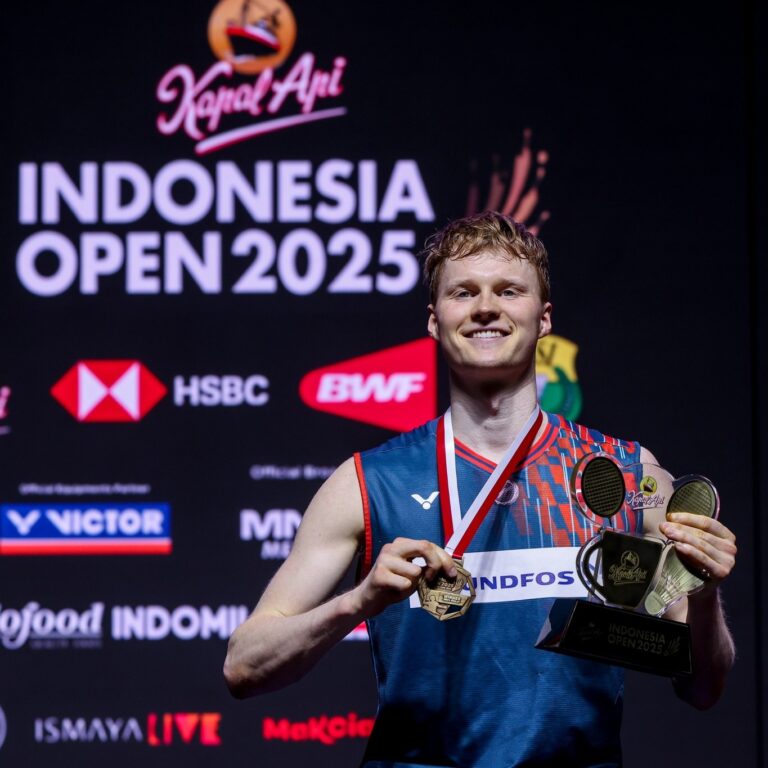Srikanth Kidambi is an Indian badminton player who is probably most famous for his singles global career. He achieved the world number one ranking in men’s singles in April 2018, an uncommon accomplishment among Indian players.
Famous for his rapid footwork and incisive smashes, Kidambi has claimed a number of titles on the BWF World Tour. To demonstrate his influence on badminton, this article discusses his childhood, professional achievements, and contribution to the game.

The Ascent
Srikanth Kidambi’s emergence as a male badminton player ties back to his roots in Andhra Pradesh and a family emphasis on athletics. His upbringing and brother’s inspiration during his formative years dedicated him to train at the Gopichand Academy, which paved the way for his participation in the Indian badminton contingent. These steps shifted him from local circuits to the national eye, marking the beginning of his ascent as a household name in Indian badminton.
Early Life
Born on 7 February 1993 in Ravulapalem, Andhra Pradesh, Srikanth was raised in an area renowned for its enthusiasm for sports, particularly badminton. His hometown provided a solid foundation, where badminton was viewed as a vehicle to reach higher and forge character, contributing to the strength of the indian badminton contingent.
His parents were a steady influence, with his father, KVS Krishna, being a landlord and his mother, Radha, a housewife. Both provided solid support, actively promoting that both sons pursue their dreams in badminton. Their belief in hard work and discipline molded Srikanth’s mindset from an early age, preparing him for the challenges of elite badminton tournaments.
Srikanth’s elder brother, K. Nandagopal, was a good badminton player. By observing and following his brother, Srikanth had a coach and an opponent at home. This sibling rivalry spurred him to improve his game and set goals, ultimately aiming for the prestigious bwf tour.
Cultural values in Andhra Pradesh, where sporting achievement is revered, drove Srikanth to give it his all. His youth was peppered with community competitions and scrimmages that fostered his ability and self-esteem, setting a strong foundation for his future in the badminton world.
Junior Circuit
Srikanth’s junior career was characterized by consistent improvement and significant victories. He took medals at the state and national level, demonstrating his potential.
Beating Junior World Champion Zulfadli Zulkiffli was a highlight. That victory gave him broader acclaim and showed he could contend with the top players of his generation.
- Bagged titles at national junior championships
- Won bronze at the 2011 Commonwealth Youth Games
- Defeated top-seeded players in junior tournaments
- Chosen for India’s squad at major youth events
He competed in the All India Junior Ranking tournaments and the Junior Asian Championships, earning experience and establishing a reputation as one of the nation’s leading young prospects.
National Stage
| Year | Competition | Result |
|---|---|---|
| 2011 | Indian National Juniors | Winner |
| 2011 | Commonwealth Youth Games | Bronze Medal |
| 2012 | All India Senior Ranking | Winner |
At the Commonwealth Youth Games, Srikanth’s bronze medal helped put India’s youth on the map. The 2011 national junior title was a defining moment, signaling his transition from junior to senior level play.
More than a trophy, winning his first national title gave him the confidence to challenge the big names of Indian badminton. After each victory, Srikanth established himself as a rising star.
He rapidly distinguished himself, noted for his quick reactions and intelligent approach. These early successes laid the groundwork for his future career.
Career Milestones
Srikanth Kidambi’s career is peppered with milestones that defined the course of Indian badminton on the global stage, particularly during elite badminton tournaments. His transition from a prodigious junior to a male badminton player of world-class caliber is characterized by consistent development and hard-fought victories.
1. The 2015 Breakthrough
Kidambi’s 2015 Swiss Open Grand Prix Gold victory was a watershed. He defeated Denmark’s Viktor Axelsen in a tight final to make history as the first Indian man to win gold at this tournament.
That same year, he supplemented with two more titles—India Open Super Series (once more over Axelsen) and the Syed Modi International Grand Prix Gold, where he defeated Huang Yuxiang.
The 2015 wins proved to the world that Indian shuttlers could win at the highest level events and not just compete. Kidambi’s success motivated contemporaries and proved to young players that Indian shuttlers could punch above their weight.
These victories fueled a confidence surge that propelled him to better performances on bigger stages, nudging him toward the world’s elite ranks.
2. Super Series Dominance
Srikanth’s BWF Super Series tenure was one of grit and consistency. He constantly popped up in the finals, demonstrating a sure hand and ice dry demeanor.
He bested top-ranked players, Olympic and World Champions, at multiple competitions. This span secured his position in the world’s top floor.
His consecutive tournament wins in 2017, comprising the Indonesia Open and Australia Open, were an anomaly for an Indian player. Every one of his titles increased his status and enhanced India’s prestige in the global badminton community.
He represented India at the 2016 Rio Olympics, placing fifth after a solid quarterfinal streak.
3. World No. 1
In April 2018, Kidambi was the first Indian man to top the BWF rankings. Wasn’t a piece of cake, this milestone.
He dealt with injuries and tough international competition, but his consistent performance particularly in Super Series events came through. Being able to hit No. 1 was when he truly began a new era for Indian badminton.
It demonstrated that Indian players could not only win big matches, but maintain a #1 ranking over an entire season. It brought more investment and attention for the sport in India.
4. World Championships Silver
In 2021, Kidambi achieved a historic milestone by reaching the World Championships finals, something no other Indian male player had done. He took silver, exhibiting talent and determination at every stage.
The medal was a huge milestone, putting Indian badminton on the map. Presented with challenging draws and tremendous pressure, he persevered, establishing himself as an elite player.
This silver, together with his 2022 Commonwealth Games bronze, demonstrated his indelible contribution.
5. Thomas Cup Triumph
Srikanth was a pivotal leader in India’s iconic Thomas Cup triumph in 2022. The victory was the nation’s inaugural win in the competition.
His games were vital to their advancement. His seasoned experience and consistent play led younger teammates. The win raised India’s stature in badminton and motivated a new generation.
He bagged two gold medals at the 2016 South Asian Games, in team and singles events.
The Kidambi Style
Srikanth Kidambi’s style of badminton is notable for its combination of brute pace, acute movement and swim and aggressive strokeplay. His style is influenced by heavy footwork, aggressive shot-making and the capacity to switch gears effortlessly, which keeps an opponent wondering.
The table below summarizes his fundamentals and why they’re important.
| Attribute | Significance |
|---|---|
| Speed & Agility | Lets him cover the court fast, chase shuttles, make quick turns. |
| Aggressive Offense | Puts pressure on rivals, forces errors, keeps the initiative. |
| Precision Smashes | Wins points outright, disrupts defenses, raises the tempo. |
| Unique Shot Execution | Uses wrist and forearm for power, spin, and deception. |
| Footwork | Helps him stay balanced, reach tough shots, return fast. |
| Adaptability | Handles different courts and rivals, adjusts game plan. |
| Mental Resilience | Recovers from setbacks, stays focused under stress. |
Attacking Finesse
Kidambi plays with an attacking flair, consistently seeking to make the first breakthrough in points. He likes to attack with smashes and rapid drives, putting his opponent on the defensive. His shots are paced and directional, hard to anticipate.
At the Indonesia Open 2017, his attack was instrumental in toppling top seeds. By maintaining a high pressure, he even breaks solid defenses. His attack-oriented style contributed to victories against some of the world’s elite.
Matches against Chen Long and Viktor Axelsen demonstrated how he can keep the pace high and induce errors. This relentless pressure means he has to conserve his stamina and minimize errors as matches drag on.
Signature Shots
Kidambi’s smash is his calling card. He whips it a little extra with his wrist and forearm, allowing him to slam down sharp angles and steep drops. His cross-court smash, in particular, has come up with winning points at key moments.
During the 2017 Australian Open final, his forehand smash turned the match in his direction. Other trademark shots are his deceptive net play and sudden backhand flicks.
These shots need precision timing and flair, and frequently catch opponents off-guard. In close matches, these special shots have made the difference, particularly when the score is tight.
Tactical Evolution
Over his career, Kidambi has evolved from a pure attacker to a more all-around player. He now blends defense with offense, changing styles depending on who he’s up against. Against defensive gurus, he drags down the game and chooses his moments.
Against speed attackers, he counterattacks and uses the full court. This shift makes him less predictable and more durable in long tournaments. He now reads situations better, making in-game changes to outsmart rivals.
Flexibility has been central to his transformation and critical to his continued success.
Resilience and Grit
Srikanth Kidambi’s world badminton story is defined by his grit and resilience, particularly as a male badminton player who faced challenges in prestigious badminton tournaments. His career underscores how setbacks do not define a player’s destiny in the competitive landscape of the badminton world.
Injury Setbacks
- Knee injury at French Open in November, later aggravated at nationals
- Recurring fitness issues that affected his ranking and consistency
- Physical setbacks at crucial tournaments, making him restructure his training
- Loss of form post-injuries that demanded reconstructing confidence and technique
There is nothing easy about returning from injury. Srikanth came back stronger after his knee injury, but it was not quick nor easy. The physical pain was equaled by the mental challenge of remaining upbeat while missing matches and training at suboptimal pace. Rehabilitation wasn’t just about repairing his body, but about trusting himself once more on court.
He leaned on support from coaches, physios and family, who kept his spirits high and his head clear.

Mental Fortitude
Srikanth’s mental edge shows up in big games. He utilizes routines to maintain his composure, such as taking a couple deep breaths before crucial points and adhering to a consistent warm-up. Staying locked in during tense moments — like his three-game slugfest against Kento Momota at the French Open — demonstrates his capacity to ward off distractions and adhere to his strategy.
The mental toughness required at this level is not only about being able to handle victory, but to persevere after defeats. A strong mindset keeps him steady as the match narrows, such as his comeback win against Popov, 24-22, in a tight finish. Faith in his method, regardless of the results, is essential to maintaining his competitive sport.
The Comeback Trail
Srikanth’s road back to the summit is paved with hard work, patience, and a crystal clear orientation towards long-term objectives. After slipping in the rankings and missing multiple major tournaments, he refused to be defined by setbacks. Landmark moments, such as his silver medal at the BWF World Championships — becoming the first ever Indian male finalist — exemplify this grit.
These are moments that don’t just capture skill, but capture the daily grind and the will to push harder. His story inspires those warring with their own demons, demonstrating that resiliency is something forged incrementally, over time.
The Architect’s Mind
Srikanth Kidambi was more than just a talented badminton player. He works like an architect on the court, blending incisive analysis with inventive play. His game is as much an exercise in strategy and ingenuity as it is in ability, just as architects combine imagination with engineering expertise to design tangible spaces.
Srikanth’s mind, like the architect’s, is wired to see the little points, adjust his strategy with the rhythm of the game, and maintain his eye on both the grand scheme and every point.
On-Court Strategy
Srikanth’s match strategies usually start with a plan, especially as a prominent male badminton player. He dissects each rally, mixing in shots that push his rivals into awkward positions. From the sidelines, he appears to rely heavily on cross-court smashes and quick net plays, making it difficult for others to anticipate him.
He reads the game flow well, particularly during elite badminton tournaments. If he notices his opponent is slow at the net, he ratchets up the pace there. If the backcourt looks soft, he attacks it with deep clears and smashes. This capacity to perceive and embrace small shifts ensures his plans are never fixed, but always fluid.
Robust design is the secret to his victories. He’s the type who hammers away at what works, but will change it up in a heartbeat if a match begins going the other way. In close games, he decelerates rallies, keeps errors down and bides his time.
This combination of quick thinking and grounded strategy frequently results in success, especially in high-stakes matches like the badminton Asia team championship.
Opponent Analysis
Studying rivals ahead of matches is a significant component of Srikanth’s preparation. He studies opposing games, identifies which shots give them trouble and studies their tendencies. Identifying weaknesses and strengths is important at elite competition.
For instance, if a player prefers forehand, Srikanth sends more shots to the weaker backhand. He may see a sluggish initial step, or a pattern in serves. This, in turn, assists him construct a plan that is safely sharp.
One to remember is his 2017 Indonesia Open victory. He went up against top-seeded players and leveraged in-depth prep to identify their habits. Armed with this insight, he took brave shot selections that returned rewards.
It demonstrates how understanding the reverse can tip the balance. Coming prepared with deep research isn’t just important in badminton, or any sport. It’s less guessing and more command.
Psychological Edge
Srikanth employs mind games to make headway. He remains unflappable when rallies get hairy, showing little expression, which can unnerve opponents. He maintains his conviction should he lag.
This consistent self-speak and concentration assist him in maintaining his duties, even in high-pressure situations. The mind side is as crucial as the body, because doubt or anxiety can shatter concentration quick.
Beyond The Court
Srikanth Kidambi, a prominent male badminton player, showcases an off-court life that adds color to his public persona, reflecting his maturity and commitment to the badminton community, especially within the Indian badminton contingent.
- Strong family bonds, relocation for training
- Early struggles with coaching and fitness routines
- Open emotional responses during key moments
- Mentoring and inspiring younger players
- Public confidence in India’s badminton future
- Ambitions for global medals
- Recognition of team achievements
Personal Life
Srikanth grew up in a close-knit family of ambitious individuals. His parents made a big decision and move, relocating him to Hyderabad where he could train alongside his elder sibling, Nandagopal, at a premier badminton academy. This choice set up his career in the Indian badminton contingent.
It was not an easy path. As a young male badminton player, Srikanth struggled to cope with the brutally demanding fitness schedules imposed by his coach, Sudhakar Reddy. He didn’t always love the hard workouts and frequently clashed with his coach’s approach. These struggles forged his grit and mentality, essential for competing in elite badminton tournaments.
The shadow of his brother — once the prodigy more destined for stardom — motivated Srikanth to put in the hours and carve his own destiny in the sport. His dedication ultimately led him to compete in prestigious events like the badminton Asia Team Championship.
Srikanth’s tie to the community is deeper than just family. He’s friendly with fans and always makes time to support badminton events. After games, he’s not afraid to display emotion. For instance, in the aftermath of a big win, he once described his reaction as ‘a little out of control.’ This open side makes him human.
A robust support system has been pivotal for Srikanth. From his family’s sacrifices to his coach’s tough love, his personal life reminds us that no athlete thrives alone.
Lasting Influence
Srikanth’s ascension has allowed India’s young shuttlers to realize their own badminton destiny. He’s a living proof that hard work and persistence do count, even if the journey is anything but smooth.
He now serves as a mentor, providing guidance and motivation to up and coming players. By sharing his own failures and development, he makes other people less isolated in their frustrations. This has garnered him admiration in addition to his match record.
It’s not just in medals that he’s building his legacy. His influence is reflected in the increasing self-belief of India’s shuttlers. Srikanth has spoken about how he believes that India can win all the gold at big occasion events like the Commonwealth Games, and his faith in the squad is evident.
His story inspires the next generation to strive, not only in sport but in tackling any ambitious objective.

Final Thoughts
Srikanth Kidambi keeps his game sharp and his focus clear. His victories represent persistence and determination, not just talent. Every match, he brings incisive movement and rapid reads. Off the court, he constructs a life that gives back and remains authentic to his roots.
Fans witness a player who stands tall in tough spots and maintains a cool head. His story remains relevant for anyone who wants to push forward, in sports or life. To track his next moves, look for updates from reliable sports sources, or check his official pages. Be near the action and follow his journey.
Frequently Asked Questions
Who is Srikanth Kidambi?
Srikanth Kidambi, a prominent male badminton player, is renowned for his speed, agility, and achievements in the international badminton circuit.
What are Srikanth Kidambi’s major career milestones?
Srikanth Kidambi, a prominent male badminton player, won four Super Series titles in 2017 and was pivotal in India’s landmark 2022 Thomas Cup triumph.
What is unique about Srikanth Kidambi’s playing style?
Srikanth, a prominent male badminton player, is known for his attacking gameplay, incisive smashes, and swift footwork, distinguishing him in elite badminton tournaments.
How has Srikanth Kidambi demonstrated resilience?
Srikanth, a prominent male badminton player, has fought through several injuries and setbacks, showcasing the resilience of the Indian badminton contingent.
What does “The Architect’s Mind” refer to in Srikanth Kidambi’s career?
It describes Srikanth, an elite badminton player, and his game plan as he adjusts strategies against adversaries in badminton tournaments.
What does Srikanth Kidambi do beyond the badminton court?
Srikanth, a prominent male badminton player, is passionate about motivating the next generation of athletes and helping to popularize badminton through his initiatives and public engagements.
Why is Srikanth Kidambi respected internationally?
His dedication to greatness and sportsmanship has made him a prominent male badminton player, inspiring fans and players in the badminton world and the Indian badminton contingent.






